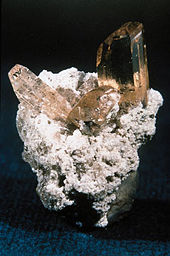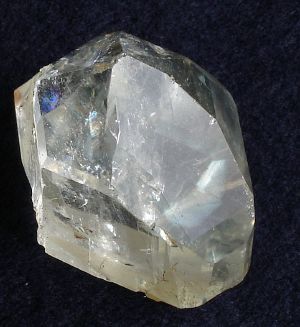Topaz
| Topaz | |
|---|---|
 an unfinished topaz crystal |
|
| General | |
| Category | Mineral |
| Chemical formula | Al2SiO4(F,OH)2 |
| Identification | |
| Color | Clear (if no impurities); also see Varieties |
| Crystal system | orthorhombic |
| Fracture | conchoidal |
| Mohs Scale hardness | 8 |
| Luster | Vitreous/glossy |
| Specific gravity | 3.4-3.6 |
Topaz is a silicate mineral of aluminum and fluorine, with the chemical formula Al2SiO4(F,OH)2. Typically, its crystals are wine or straw-yellow in color, but they can also come in a variety of other colors, including green, blue, pink, gray, or white. The stones are mainly used as gems in jewelry.
Etymology
The name "topaz" is derived from the Greek topazos, "to seek," which was the name of an island in the Red Sea that was difficult to find and from which a yellow stone (now believed to be a yellowish olivine) was mined in ancient times. In the Middle Ages the name topaz was used to refer to any yellow gemstone, but now the name is only properly applied to the silicate described above.
Occurrence
Topaz is commonly associated with silicic igneous rocks of the granite and rhyolite type. It typically crystallizes in granitic pegmatites or in vapor cavities in rhyolite lava flows like those at Topaz Mountain in western Utah. It may be found with fluorite and cassiterite. It can be found in the Ural and Ilmen mountains, Afghanistan, Czech Republic, Germany, Norway, Pakistan, Italy, Sweden, Japan, Brazil, Mexico, and the United States.
The biggest topaz crystal ever found, named "El Dorado," was found in Brazil in 1984. It weighs 6.2 kilograms and belongs to the British Royal Collection.
Characteristics
Topaz crystallizes in the orthorhombic system and its crystals are mostly prismatic terminated by pyramidal and other faces, the basal pinacoid often being present. It has an easy and perfect basal cleavage, meaning that gemstones or other fine specimens have to be handled with care to avoid developing cleavage flaws. The fracture is conchoidal to uneven. Topaz has a hardness of 8 on the Mohs scale, a specific gravity of 3.4-3.6, and a vitreous luster.
Pure topaz is transparent but it is usually tinted by impurities that give it a variety of colors and may make it translucent. The colors include wine or straw-yellow, white, gray, green, blue, pink or reddish-yellow. When heated, yellow topaz often becomes reddish-pink. The stone can also be irradiated, giving it a light and distinctive shade of blue. A recent trend in jewelry is the manufacture of topaz specimens that display iridescent colors, by applying a thin layer of titanium oxide via physical vapor deposition.[1]
Historical and cultural significance
- According to Rebbenu Bachya, the word "Leshem" in the verse Exodus 28:19 means "Topaz" and was the stone on the Ephod representing the tribe of Dan.
- Yellow topaz is the traditional November birthstone.
See also
Notes
- â A famous gemstone created by physical vapor deposition is called "Mystic Fire Topaz." Azotic Coatings patented this name in 1998. Retrieved March 23, 2007.
ReferencesISBN links support NWE through referral fees
- Hurlbut, Cornelius S., and Cornelis Klein. 1985. Manual of Mineralogy, 20th ed. New York: John Wiley. ISBN 0471805807
- Sofianides, Anna S., and George E. Harlow. 1997. Gems & Crystals. London: Parkgate Books. ISBN 1855853914
- Weinstein, Michael. 1967. The World of Jewel Stones. New York: Sheridan House. ASIN B000IN1RC4
External links
All links retrieved April 30, 2023.
Credits
New World Encyclopedia writers and editors rewrote and completed the Wikipedia article in accordance with New World Encyclopedia standards. This article abides by terms of the Creative Commons CC-by-sa 3.0 License (CC-by-sa), which may be used and disseminated with proper attribution. Credit is due under the terms of this license that can reference both the New World Encyclopedia contributors and the selfless volunteer contributors of the Wikimedia Foundation. To cite this article click here for a list of acceptable citing formats.The history of earlier contributions by wikipedians is accessible to researchers here:
The history of this article since it was imported to New World Encyclopedia:
Note: Some restrictions may apply to use of individual images which are separately licensed.
